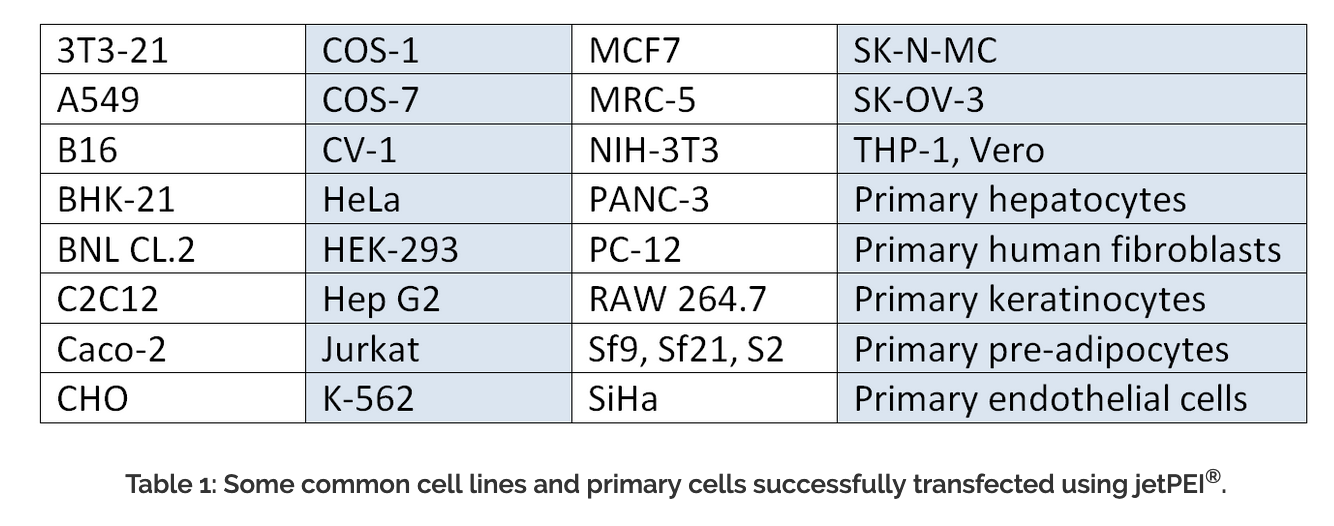Description
Less siRNA, less off-target effects
Several publications show that transfecting low siRNA concentrations avoids off-target effects. Indeed, these unwanted non specific side-effects are observed when transfecting siRNA at high concentrations (1,2). Hence, the reliability of the experimental data can be increased by using as little siRNA as possible. This is why INTERFERin® has been specifically designed to provide high silencing efficiency using low siRNA concentrations.
INTERFERin®-mediated delivery of 1 nM of a specific siRNA shows selective and highly efficient knockdown of gene expression, while a competitor (L2K) needs at least 10 nM siRNA to reach 50% silencing efficiency (Fig. 1).

Amazingly, 50% silencing is still achieved at 10 pM siRNA (Fig. 2).

Transfection of 1 nM siRNA targeting endogenous lamin A/C with INTERFERin® drastically reduces lamin gene expression to barely detectable level (Fig. 3).

1. Birmingham, A. et al., (2006) Nature Methods, Vol.3, No3, 199-204
2. Caffrey, D. et al., (2011) PLoS One. 2011;6(7):e21503. Epub 2011 Jul 5.
Suitable for miRNA transfection
Transfection of microRNA (miRNA) oligonucleotides is increasingly being used to analyze biological effects of specific miRNAs on cell function. INTERFERin® is the reagent of choice for delivering miRNA, miRNA mimics or pre-miRNAs.
INTERFERin® is the latest generation siRNA & miRNA transfection reagent, especially designed for high transfection efficiency in a wide variety of cells, resulting in high gene silencing or stimulation of gene expression. Indeed, some miRNA are also known to induce gene expression by association with the promoter of the gene of interest. For example, INTERFERin®-mediated delivery of miR-373 leads to a 3 fold increase in E-Cadherin expression (Fig. 4).

The cationic components of INTERFERin® require very little oligonucleotide amount, resulting in a gentle transfection process. In addition, the easy and robust protocol ensures reproducible results. Oligonucleotides like miRNA can be transfected with small quantities of INTERFERin® resulting in strong gene silencing or stimulation of gene expression. Whatever the concentration of INTERFERin® used, the effect stays approximately the same making INTERFERin® an economical reagent. For example, the fold change using different volume of INTERFERin® is always between 1.5 and 1.8 (Fig. 5).

High transfection efficiency associated with high cell viability makes INTERFERin® the reagent of choice for generating relevant data for scientific publications. Indeed, the number of publications using INTERFERin® for miRNA and miRNA related molecules has been exponentially growing since its launch (Fig. 6).

Over 90 % gene silencing
For many adherent cell lines or primary cells, 1 nM siRNA is sufficient to obtain more than 90 % gene silencing. For suspension cell lines, 80 % silencing can still be reached by INTERFERin® using 5 nM siRNA (Table 1).

Specific conditions for various cell lines are available in our Polyplus-transfection Database.
Excellent cell viability
When it comes to cell viability, INTERFERin® outperforms other transfection reagents. 48 h after transfection with 1 nM siRNA, cells transfected with INTERFERin® appear healthy, while toxicity is clearly observed with reagent S (Fig. 7).

Easy standard protocol
INTERFERin® is ready to use and the protocol is straightforward. A starting concentration of 1 nM siRNA ensures silencing of most genes in most cell types (Fig. 8).
INTERFERin® is compatible with both serum and antibiotics, hence avoiding any time consuming washes and medium changes; furthermore INTERFERin® can be left on the cells without any adverse effects.





Reviews
There are no reviews yet.